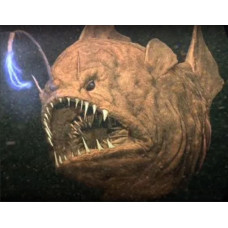Latin name
Lophius piscatorius
Other names
European angler, common monkfish.
Identification
The body is naked, covered with numerous leathery growths and bony tubercles. On either side of the head, along the edge of the jaws and lips, hang fringes of skin that move in the water like algae, making them inconspicuous on the bottom. The body is flattened, compressed dorsally and ventrally. The head is flat, broad and flattened at the top. The mouth is large, semicircular, with the lower jaw protruding forward and sharp hooked teeth. The eyes are small. The gill openings are wide and located below the bases of the pectoral fins. The skin is soft and unscaled; there is an abundant fringe of skin along the edge of the body.
Features of fish fins
The anterior dorsal fin consists of six rays, the first three of which are isolated. The very first ray of the dorsal fin is transformed into a "stick" (illicium) with an esca at the end. The end of the esca bifurcates into two flat, broad, leaf-like petals. The length of the illicium reaches 25% of the body length. The second dorsal (10-13 soft rays) and anal (9-11 soft rays) fins are located opposite each other near the caudal peduncle. The pectoral fins are very large and widened at the end. They can make rotational movements that allow the fish to crawl along the bottom. The pelvic fins are located on the throat.
Fish colouring
Back is brownish, greenish-brown or reddish with dark spots. The ventral side is white, except for the black posterior edge of the pectoral fins.
Distribution
Widespread in the Atlantic Ocean off the coast of Europe from Iceland and the Barents Sea to the Gulf of Guinea and the Black Sea, the North Sea, the English Channel and the Baltic Sea.
Habitat
Typical bottom dwellers, usually found on sandy and muddy bottoms (sometimes half buried), among algae and between rock fragments, at depths of 20-1000 metres.
Size
Body length - up to 2 m, more often 1-1.5 m. Maximum mass 57.7 kg.
Behavior
More often, it lies motionless and blends in with the bottom, luring its prey with an esca bait. As it swims towards the hunter, the fish opens its mouth in a fraction of a second and sucks in the water along with the prey.
Food and feeding habits
The main food is fish. It can crawl after fish and even jump up with the help of hand-like pectoral fins.
Reproduction
Males mature at 6 years of age with an average body length of 50.3 cm and females mature at 14 years of age with a body length of 93.9 cm. They spawn off the British Isles from March to May and off the Iberian Peninsula from January to June. Spawning takes place at considerable depths (400-2000 m). Females lay eggs in the form of a jelly-like strip up to 9 m long and 90 cm wide. Juveniles move to the bottom when they are 5-6 cm long.
Fishing
Commercial fish. The flesh is white, dense and boneless. Particularly popular in France and Italy.
| Classification | |
| Phylum | Chordata |
| Class | Actinopterygii |
| Squad | Lophiiformes |
| Family | Lophiidae |
| Genus | Lophius |
| Species | L. piscatorius |
| Features | |
| Conservation status | Least Concern |
| Habitat | Bottom |
| Life span, years | No information |
| Maximum body weight, kg | 57,7 |
| Maximum length, cm | 150 |
| Sailing speed, m/s | No information |
| Threat to people | Edible |
| Way of eating | Predator |
Angler
Tags: angler

